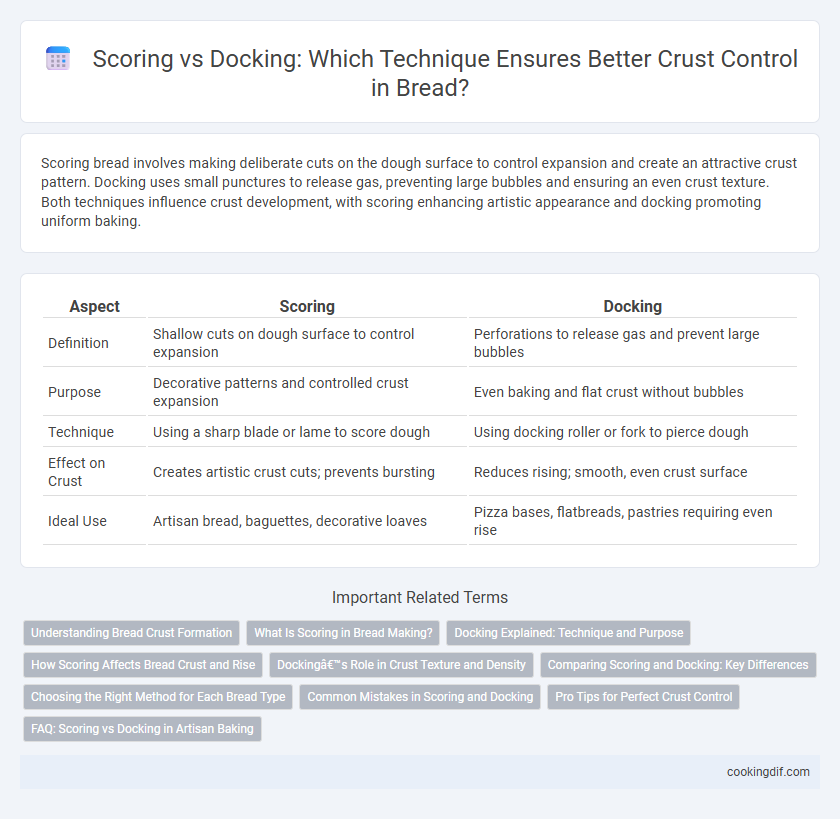Scoring bread involves making deliberate cuts on the dough surface to control expansion and create an attractive crust pattern. Docking uses small punctures to release gas, preventing large bubbles and ensuring an even crust texture. Both techniques influence crust development, with scoring enhancing artistic appearance and docking promoting uniform baking.
Table of Comparison
| Aspect | Scoring | Docking |
|---|---|---|
| Definition | Shallow cuts on dough surface to control expansion | Perforations to release gas and prevent large bubbles |
| Purpose | Decorative patterns and controlled crust expansion | Even baking and flat crust without bubbles |
| Technique | Using a sharp blade or lame to score dough | Using docking roller or fork to pierce dough |
| Effect on Crust | Creates artistic crust cuts; prevents bursting | Reduces rising; smooth, even crust surface |
| Ideal Use | Artisan bread, baguettes, decorative loaves | Pizza bases, flatbreads, pastries requiring even rise |
Understanding Bread Crust Formation
Scoring bread dough creates controlled weak points that guide expansion during baking, resulting in a more uniform crust with distinct patterns. Docking involves perforating the dough surface to release steam and prevent large blister formation, leading to a thinner, less blistered crust texture. Understanding the balance between scoring and docking techniques is crucial for optimizing crust appearance and texture in artisanal bread making.
What Is Scoring in Bread Making?
Scoring in bread making involves making shallow cuts on the dough's surface using a sharp blade or lame before baking, which allows controlled expansion and prevents random tearing. This technique influences the crust's texture and appearance by directing the bread's rise and creating aesthetic patterns. Proper scoring enhances oven spring and crust formation, contributing to the bread's overall quality and visual appeal.
Docking Explained: Technique and Purpose
Docking is a technique in bread baking where small holes or perforations are made on the dough surface before baking to control crust expansion and prevent unwanted blistering. This method allows steam to escape evenly, resulting in a uniform, flat crust and improved texture. Docking enhances the appearance and structural integrity of bread by managing gas release during oven spring.
How Scoring Affects Bread Crust and Rise
Scoring bread allows controlled expansion during baking by directing where steam escapes, which prevents random cracks and promotes even rise. Proper scoring depth influences crust thickness and texture, enhancing the crust's crispiness while maintaining the loaf's internal crumb structure. This technique improves oven spring by enabling dough expansion without compromising shape or crust quality.
Docking’s Role in Crust Texture and Density
Docking plays a crucial role in controlling crust texture and density by allowing steam to escape during baking, preventing excessive puffing and uneven crust formation. This technique creates uniform perforations that guide crust expansion, resulting in a more consistent and thinner crust compared to scoring, which mainly influences aesthetic patterns and larger venting spaces. By improving moisture release through docking, bakers achieve a balanced crust texture that enhances the overall bread quality.
Comparing Scoring and Docking: Key Differences
Scoring and docking are two distinct techniques used in bread baking to control crust formation and expansion. Scoring involves making shallow cuts on the dough surface, allowing controlled release of steam and directional expansion, which creates decorative patterns and prevents random bursting. Docking, on the other hand, uses small punctures or holes to release gas evenly throughout the dough, resulting in a more uniform crust with fewer large air pockets, commonly applied in flatbreads and pizza crusts.
Choosing the Right Method for Each Bread Type
Scoring creates controlled surface expansion in artisan breads like sourdough, enhancing crust texture and appearance by directing steam release during baking. Docking is more suitable for flatbreads and pizza dough, minimizing large air bubbles and promoting even baking by puncturing the dough surface. Selecting the method depends on the bread type's structure and desired crust characteristics to achieve optimal baking results.
Common Mistakes in Scoring and Docking
Common mistakes in scoring bread dough include cutting too shallow or too deep, which can either restrict oven spring or cause excessive expansion and uneven crust formation. Improper docking, such as using insufficient or irregular perforations, often leads to uneven crust texture and overly dense areas inside the loaf. Precise control of both techniques optimizes steam release and crust development for a visually appealing and well-textured bread.
Pro Tips for Perfect Crust Control
Scoring bread dough with sharp blades before baking allows controlled expansion and prevents random cracks, resulting in an attractive crust texture and pattern. Docking, or piercing the dough with a tool, releases steam and reduces large air bubbles, ensuring an even crust without excessive blistering. Use precise scoring angles and avoid over-docking to balance crust crispiness and crumb softness for perfect artisanal bread.
FAQ: Scoring vs Docking in Artisan Baking
Scoring in artisan bread baking involves making deliberate cuts on the dough surface to control expansion and create decorative patterns while allowing steam to escape, resulting in a crispier crust. Docking, by creating multiple small holes with a tool or fork, prevents excessive rise in specific areas and produces a more uniform, less blistered crust. Bakers choose scoring for aesthetic and controlled oven spring effects, while docking is preferred for flatbreads or rolls needing an even texture without large air pockets.
Scoring vs Docking for crust control Infographic

 cookingdif.com
cookingdif.com